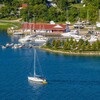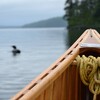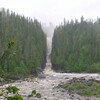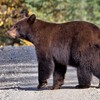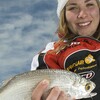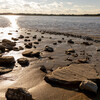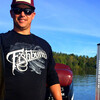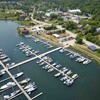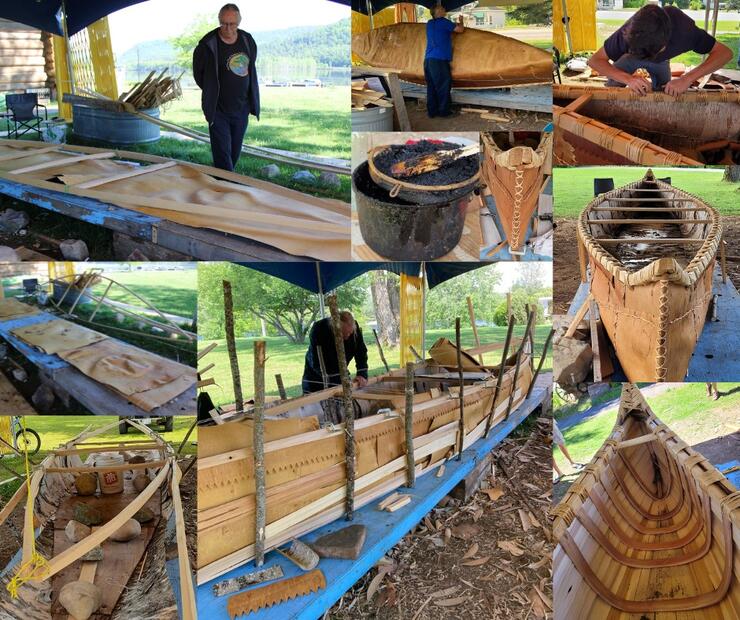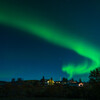
Mahigan's Gift: Paddling Tradition to Ottawa
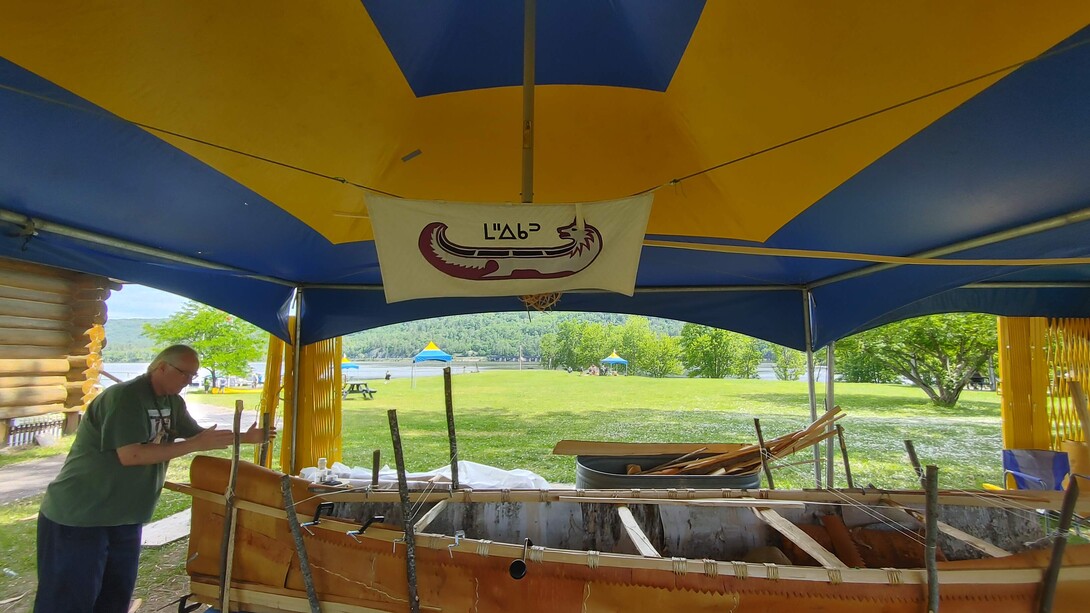
A gift to the people of Turtle Island is taking shape at the Mattawa Museum in Northeastern Ontario. Located on the banks of the Ottawa River, on the traditional and unceded territory of the Algonquin Nation, the Mattawa Museum has partnered with Indigenous canoe maker Mahigan to build a special birch bark canoe, called the Gift.
Mahigan, or Marcel Labelle—his English name—is an Algonquin and Métis husband, father, and grandfather who has been building canoes and sharing teachings around the canoes he creates for over 40 years. Mahigan is passionate about creating awareness around Indigenous culture—and what better artefact to showcase that concept than the canoe?
I was privileged to join Mahigan for an afternoon and learn about traditional canoe building and the teachings and respect associated with the Gift that he is creating in his own backyard.
"Why I'm doing this is to remind people that we did work well together in the past. so we can do it again." —Mahigan
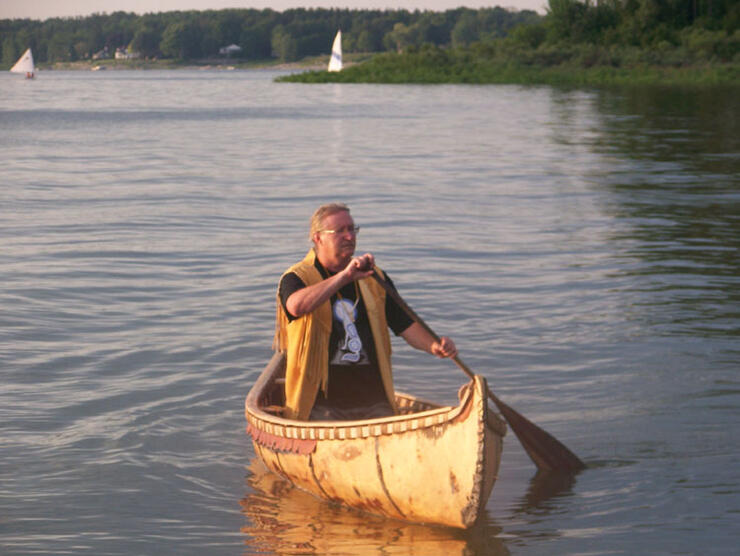
how did you start making canoes?
I was born beside the church [Mahigan points up the hill] and I grew up with a family of trappers. My father taught me a lot about the wilderness and the trees. Apparently, when I was a little guy, maybe four years old, there was a guy who was building canoes. And as a teenager I watched Andy Green [a local Algonquin] build a big canoe.
- One of Marcel's canoes is now in the Canadian Canoe Museum
Then I became a trapper, like my ancestors. I trapped on 225 square km of land. I worked for the Ontario Trappers Association as a trapper instructor and as a beaver grader for North Bay Fur sales. I also helped develop a series of systems for trappers in the province of Quebec, and a series of educational videos called Focus on Trapping. So life was good as a trapper, I could feed my family very well. But in the early 90s, people stopped buying my product and I had to stop trapping. I got real sick, so sick that I almost died. The doctors thought I had a heart condition. They went into my heart for bypass surgery, but there was nothing wrong. I had a broken heart. It was more emotional than physical.
With the help of my family and my wife Joanne, I went back to school. I graduated from Nipissing University in 1997. But then you had a trapper with a degree and not too many people hire that. I ended up in Southern Ontario in 2000 and I worked in an office. I didn't do well in an office. I'm an outdoors guy and I started getting ill again. Before it went too deep, too dark, I shared a vision I was getting with a pipe carrier—a friend of mine—and he helped me understand my vision. It was to go bring tobacco into the Rocky Mountains.
So I quit my job and the journey started at Six Nations at the first moon in June and then we went all across Turtle Island, to Tofino, and on Vancouver Island we smoked the pipe and headed back East. In my vision I could see specific peaks, snow caps and when we got around Roger's Pass I found those peaks. Well I didn't find them, they were already there, but I saw them in real life. So that's where I offered Tobacco.
If you ever go there, there's a picnic area, there's a bench and it says a young man died in a car crash and he died young but he lived his life well. And that's where I left the tobacco. Then the message was, go back to your trap land and build. I didn't know what to build, so this is what happened [Mahigan shows a picture of the first canoe].
That summer I built three [canoes]. Someone offered to pay me $100,000 for the year to build three canoes but teach six people [how to make them] and then in the future the canoes would become mass-produced [Mahigan shakes his head].
"People ask me about the blueprint of a canoe—the blueprint is our body. The skin is the bark, the muscles are the cedar sheathing..." —Mahigan
[A friend asked] 'What do you want to do?' And I said I wanted to show my culture, so he said 'Do you want to do a small interview in Toronto?' I said sure, I got the address, plugged it into my GPS.
I ended up at the SkyDome, Roger's Centre. I said I think I have the wrong address and the guy at the gate said no, we've been waiting for you, and he opened the big gate and I drove my pickup truck with a canoe on top. It was the Canadian Aboriginal Festival where 10,000 people showed up...I ended up on Breakfast Television and I said on air 'I want to build canoes and share my culture through canoe building' and that's when it just opened up. People saw that and I've been invited to primary schools, high school, college, university, from here to BC.”
In your lifetime, how many canoes have you've built?
When I start counting in my head, I lose count, but it's about forty, that we can paddle. I built four or five for display. A friend of mine, an Ojibway artist, his name is Rene Meshake—he and I did an Ontario Arts Council project together where I built a four-footer with ceremony and all detail and he uses that canoe to teach Anishinaabemowin. Some projects like that. Joanne [Mahigan's partner] teaches kids to make one-foot canoes from the birch bark scraps.
Would you say that's the smallest canoe you've made?
“Yeah, one foot.”
And the biggest?
“26 feet long, five feet wide and it floats about three tonnes, her name is Kokomis.
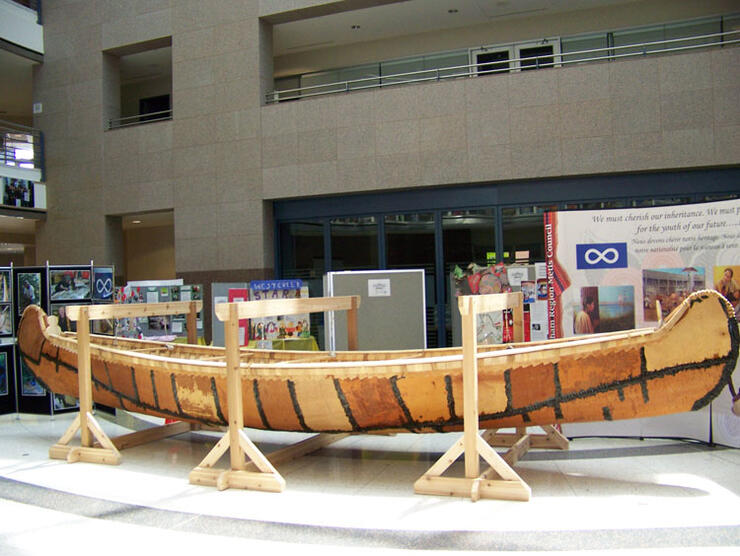
tell us about the canoe you’re creating here in mattawa
Twenty feet, 4 feet wide. This one you'll be able to put about ten people in it. This one is going to be paddled to Ottawa, so it's called the Gift.
I do many presentations, and one of the things I share is that I'm Métis. Four hundred years ago my French ancestors came here and they were met by my Anishinaabe ancestors and this is the gift that they shared. And for a long time they worked well together—if not I wouldn't be here, right? Canada wouldn't be here without this gift, the canoe. About confederation time, [they didn't work together] not so well, so why I'm doing this is to remind people that we did work well in the past so we can do it again, talking reconciliation. I think that's the truth, that we did work well at one point and we have the pattern for that, and it's in the canoe too. So we're gonna bring this [to Ottawa]. I'd like to paddle it down the river, not just me, many people participate because it's not about one person, it's about bringing people together and then portage on Parliament Hill and tell people about the gift—something positive.
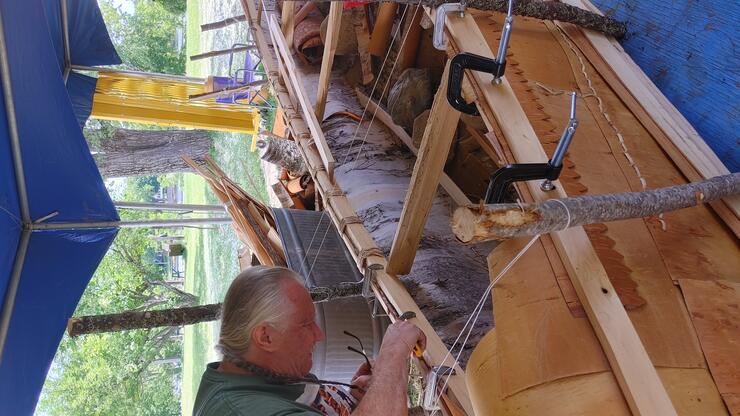
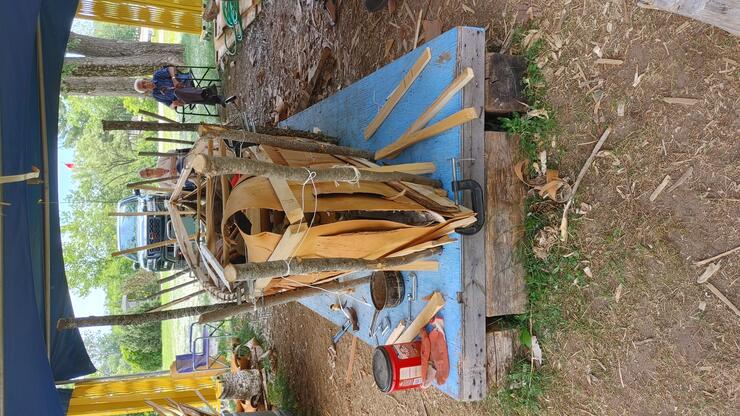
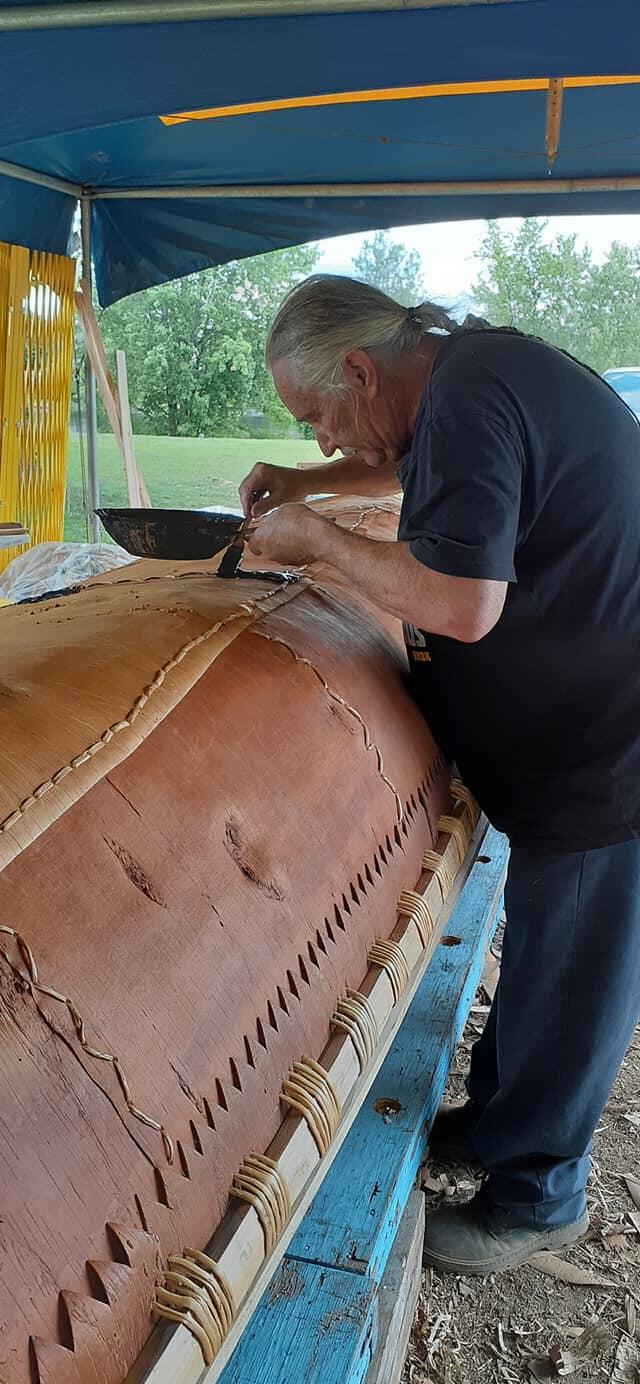
Adding the spruce gum // Source: Marcelle Labelle Facebook
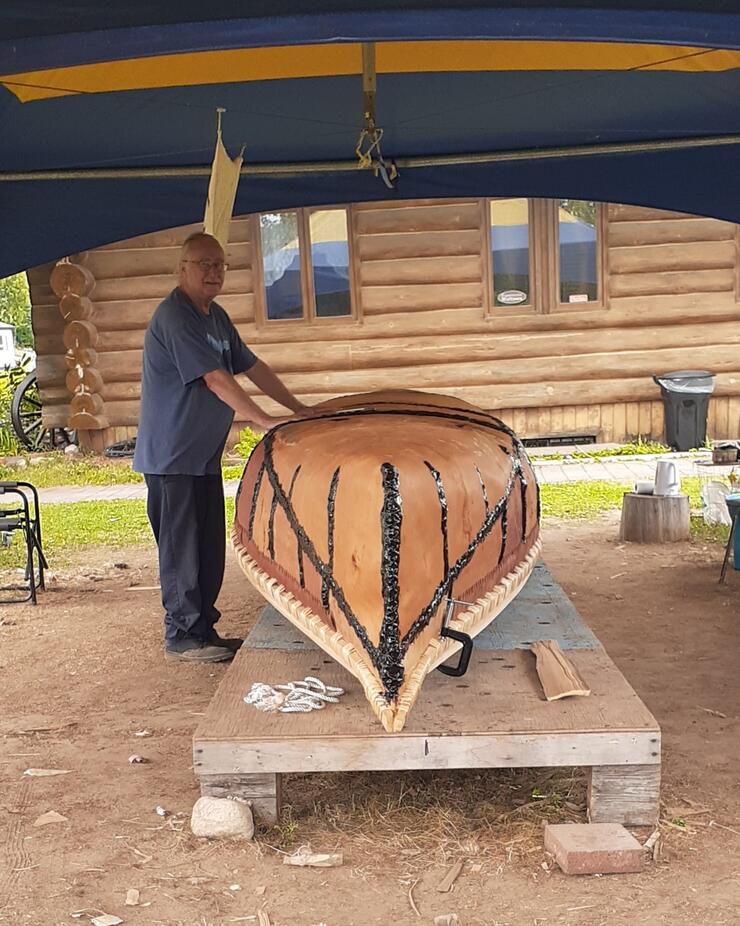
The finished canoe // Source: Marcelle Labelle Facebook
how long does it take to build a canoe like this?
That's a two-part answer. When Judy [the Mattawa Museum curator] told me the project was a go, I went out for a walk and this cedar tree called me. So in January I did ceremony for the cedar that you see and went back and cut the tree down and split it into chunks and with my snowshoes, carried it home. So most of this is the same tree. On May 18th, I set up the platform and I had to wait about a week for the bugs to be at their prime to harvest the other material which took me about a week, and it should be finished mid to late August—and in late August, early September is when the paddle to Ottawa will happen.
The bottom of this canoe looks flat-bottomed, I pictured it being rounded. Will it change?
Yes, that's just temporary. Once the frame is made, I insert sheathing. It's a two year—hand split cedar and it covers all the bark on the inside. At every space along the canoe, between the [spruce root] there will be a cedar rib, which I will smash in with a sledgehammer to make the rounded bottom. To seal the seams I use spruce gum, but the spruce gum in the sun just melts off, there's no coagulant—like our blood. So I burn all the leftover wood shavings and I incorporate the ashes so it cements it—which is brittle so when it gets cold it can crack off. So I add bear fat to make it softer but more important, the bear is a protector spirit so we have the protector with us when we canoe.
People ask me about the blueprint of a canoe—the blueprint is our body. So the skin is the bark, the muscles are the cedar sheathing, the cedar ribs are like your ribs, the thwarts are considered the sternum; the roots are the tendons, like in your hands, where the tendons grasp together. There are five holes for the roots, for our five digits. The spruce gum is the blood.
Have you collected all the pieces of the canoe yourself?
Yes, I'm still missing a few pieces, but I'll have those in a few weeks. My grandson is coming to help me build the rest of the canoe.
Do you collect everything within the Mattawa area?
Yes all within a 15-minute drive of the museum. I only live about 9 km from here. My family helped us build our home.
What is the most interesting or rewarding part of canoe building?
For me it's been sharing my story. The little kindergarteners who come and want to smell everything and ask 'can I take this home with me?'
And then sharing it with my dad. [Marcel points to an older man sitting nearby in a folding chair]. The pride in his eyes watching me is so rewarding.
So many people are starving for the truth and I'm surprised when I even mention the Indian Act that so many Canadians don't even know it exists. In 2017 I built a canoe in BC, it's called the Indian Act, 2017, to celebrate [Canada's] 150th. And the Indian Act is still here…When I was a little guy, we had to hide who we were. Dad said 'shh shh shh, don't tell anyone that we're Indigenous.'
Today I talk to people here from BC, from Florida, from Mexico, from the East Coast. They've all been here in the last month and they're starving to know more about who we are, and this is who we are: This is the blueprint of our body. That's a story I like to share, the creation story. Everyone on this earth is the blueprint.
What's the most challenging or difficult part of creating a canoe?
It's all physically demanding but I would have to say... the indicator for the right time to harvest birch bark is that it's peak blackfly and mosquito season. [Marcel laughs] I don't cut the tree down, I leave it standing, so I'm up there on the ladder and I don't use bug spray. The blackflies, the mosquitos. Now and then the deer flies jump in. I'd say that's the most annoying for sure. I think that's why there aren't that many traditional canoe builders out there. Other than that it's so enjoyable, especially working with the materials.
What should people be mindful of when they are canoeing the waterways?
If you bring it in, bring it out. But the fact that you're already in a canoe is a good step.
visit the mattawa museum and learn more about traditional canoe making
The work Mahigan is doing, both in building a canoe and taking the time to speak and teach every visitor who stops in to see him is truly inspiring and heartwarming. His passion for teaching and his craft are something that our world needs more of and this canoe and this man are truly a gift that will help bring together the people of Turtle Island. To learn more about The Gift and Mahigan's other canoe which is on display at the museum, visit the Mattawa Museum website.
Editor's note: This interview has been edited and condensed for clarity.
Recommended Articles

Northern Lights in Northeastern Ontario
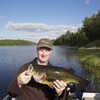
Lake Nipissing Fishing Hot Spots
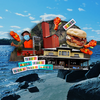
Best Things to Do in Kirkland Lake: The Town that Gold Built
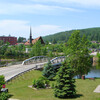
Stompin' Tom sang about it. The fur traders paddled through it. And the town's mayor made it famous.
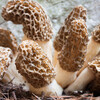
A Guide to Mushroom Hunting
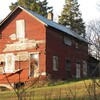
Spectres of the Past: A Ghost Town Field Trip
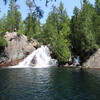
Ontario's Secret Lagoon
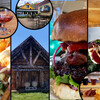
A Culinary Tour of Temiskaming Shores
Ice Fishing, Eh?
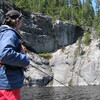
5 Fishing Hotspots in Timmins & Area
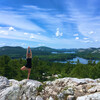
Top 5 things to do in Killarney, Ontario
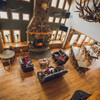
West Nipissing - A Sensational Place to Vacation
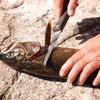
Best Ways to Fillet a Fish
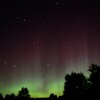
The Northern Lights Trip Planner
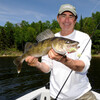
Early Season Tips For Walleye Fishing
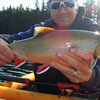
Fish for one of the World's Rarest Species of Trout
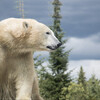
Cochrane: Wonderfully Unexpected

The Humble Blueberry
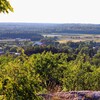
Small-town gems in Northeastern Ontario
